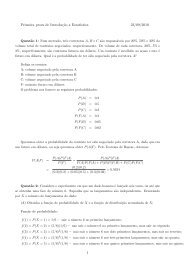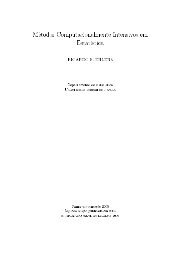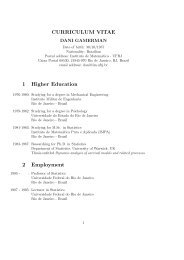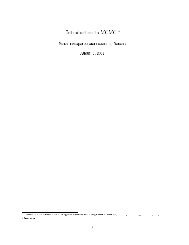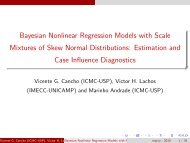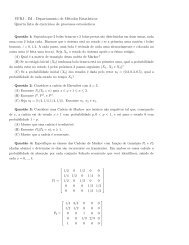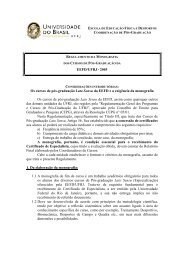Copulas: a Review and Recent Developments (2007)
Copulas: a Review and Recent Developments (2007)
Copulas: a Review and Recent Developments (2007)
You also want an ePaper? Increase the reach of your titles
YUMPU automatically turns print PDFs into web optimized ePapers that Google loves.
2.4 Time dependent copulasIn practice, a powerful tool to specify the underlying model are the conditional distributionswith respect to the past observations. They are more useful than the jointor marginal unconditional distributions <strong>and</strong> have become a st<strong>and</strong>ard tool in ¯nance<strong>and</strong> insurance, see Embrechts et al. (2002), Cherubini et al. (2004), Patton (2006),Fermanian <strong>and</strong> Scaillet (2005), Fermanian <strong>and</strong> Wegkamp (2004). The reason is thepresence of temporal dependencies in returns of stock indices, credit spreads or interestrates of various maturities, etc.In Finance <strong>and</strong> Economics, it is often necessary to simulate the future values ofsome market factor, say S, atvariousdatest>0. Knowing the spot value S 0 today,future realizations of S t given S 0 have to be simulated. Therefore, the dependencefunction C 0;t (:jS 0 ) needs to be speci¯ed. A ¯rst attempt to formalize the functionC 0;t (:jS 0 ) for a ¯xed horizon t is due to Patton (2006) who introduced the conditionalcopula in bivariate case as follows.De¯nition (conditional bivariate copula, Patton (2006)). Let X; Y <strong>and</strong> W becontinuous r<strong>and</strong>om variables. The conditional copula of (X; Y )jW ,whereXjW » F W<strong>and</strong> Y jW » G W , is the conditional joint distribution function of U = F (XjW ) »U(0; 1) <strong>and</strong> V = G(V jW ) » U(0; 1) given W .Therefore, the conditional bivariate copula is the joint distribution of two conditionallyU(0; 1) r<strong>and</strong>om variables. In general, the n-dimensional conditional copulais derived from any distribution function such that the conditional joint distributionof the ¯rst n variables is a copula for all values of the conditioning variables. It issimple to show that conditional copula satis¯es the properties similar to the usualcopula. The following version of Sklar's theorem holds.Sklar's Theorem (for conditional bivariate copula, Patton (2006)). Let H Wbe the joint conditional distribution function with marginal distribution of (X; Y )jW .Let F W be the conditional distribution of XjW <strong>and</strong> G W be the conditional distributionof Y jW . Assume X <strong>and</strong> Y are continuous in x <strong>and</strong> y. Then there exists a uniqueconditional copula C W such thatH W (x; yjw) =C W (F W (xjw);G W (yjw)jw) for all (x; y) 2 [¡1; 1] 2 <strong>and</strong> each w 2 −:Conversely, for any conditional distribution functions F W <strong>and</strong> G W <strong>and</strong> any conditionalcopula C W , the function H W de¯ned above is a conditional two-dimensionaldistribution function with marginals F W <strong>and</strong> G W . ¥There exists a complication, coming from the assumption that the conditionalvariable W must be the same for both marginal distributions <strong>and</strong> the copula. Itfollows a supporting example.13




